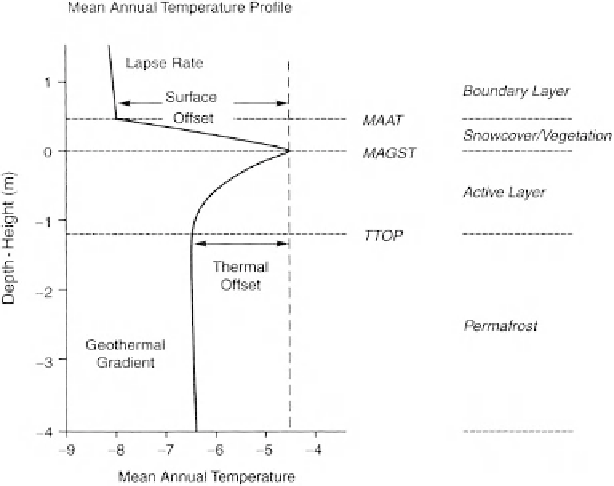Geology Reference
In-Depth Information
Figure
3.3.
A schematic graph that illustrates the mean annual temperature profi le through the
surface boundary layer in a cold region. It shows the relation between air temperature and ground
temperature. From Smith and Riseborough (2002). Reproduced by permission of John Wiley &
Sons Ltd.
magnitude of the freezing and thawing indices at the locality concerned, the nature of the
vegetation, and the amount, nature, and duration of snow cover. Because the effects of
snow cover in winter are generally greater than those of vegetation cover in summer, the
MAGST is usually higher than the MAAT.
Therefore, the thermal offset is defi ned as the difference between the MAGST and the
temperature at the top of permafrost (TTOP). While the magnitude of the offset depends
directly upon the air-thawing index, it is also determined by the thermal conductivity ratio
that must exist between thawed and frozen earth materials. In the case of solid bedrock,
where moisture amounts are minimal, this ratio approaches unity and there is little or no
thermal offset. However, in most mineral soils the thermal conductivity ratio, or typical
n-factor, ranges between 0.6 and 0.9. The greatest range occurs in organic materials (peaty
soils), where values range from about 0.3 or less under saturated conditions to close to 1.0
for dry conditions (Riseborough and Smith, 1998).
The thermal offset concept can be applied to tundra lakes. The seasonal maximum ice
thickness in the lake environment can be regarded as analogous to the active layer or the
zone of seasonal freezing in the terrestrial environment (Riseborough, 2006). The lake-
offset value largely refl ects the different thermal regime that must exist under ice-covered
and ice-free conditions. Offsets in excess of 10 °C are not uncommon in deep lakes and
are often the cause, in permafrost terrain, of unfrozen zones existing beneath lakes. This
topic is discussed more fully in Chapter 5.
In summary, while air temperature is an important defi ning characteristic of periglacial
climates, ground and surface temperatures are probably more important in the geomor-
phological context. Seasonal snow cover, soil moisture (thermal conductivity), and ground-
thermal properties are crucial site-specifi c factors that need to be considered.

